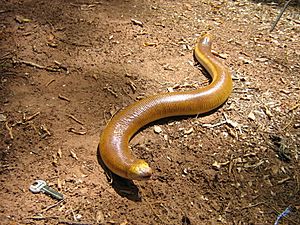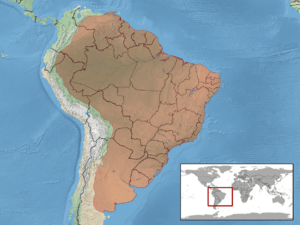Red worm lizard facts for kids
Quick facts for kids Red worm lizard |
|
|---|---|
 |
|
| Conservation status | |
| Scientific classification | |
| Genus: |
Amphisbaena
|
| Species: |
alba
|
 |
|
| Range of A. alba (in red) in South America | |
The red worm lizard, also known as Amphisbaena alba, is a unique type of lizard. Sometimes it is called the white or white-bellied worm lizard. It belongs to a group of reptiles called amphisbaenians. These creatures are often hidden, so scientists don't know much about their daily lives.
Red worm lizards eat many different things. Their diet includes plants and small animals. They might eat other lizards and their eggs, snakes, mice, and other rodents. Most of their diet is made up of beetles, ants, and spiders. They also enjoy insect larvae, cockroaches, crickets, grasshoppers, and termites. Spiders, scorpions, and worms are also on their menu. Female red worm lizards are a bit bigger than males. They can grow to be over 80 centimeters long, which is quite large for a worm lizard! These lizards often bury themselves. They might hide in leafcutter ant nests or even in the ants' garbage piles. This helps them avoid bothering the ants and also keeps them safe from predators.
Contents
Where Red Worm Lizards Live
The red worm lizard lives in many parts of South America. You can find them from eastern Venezuela and the island of Trinidad. Their home stretches across the entire Amazon Basin down to northern Argentina. Amphisbaena alba has the biggest living area of all worm lizards.
Reproduction and Life Cycle
Red worm lizards reproduce during the dry season in their habitat. There is some evidence that they might use the nests of leaf-cutting ants to lay their eggs. A. alba lays more eggs at one time than other worm lizards. They can lay between 8 and 16 eggs. This is probably because of their larger body size. Male and female red worm lizards look very similar. Their body length and other features are alike. This is likely because their bodies need to be a certain way for burrowing.
Red worm lizards have special glands near their tail. These glands are probably used for reproduction and marking their territory. The glands produce a sticky substance. When the lizard moves through tunnels, this substance is left behind. It creates a trail for other lizards to follow.
How Red Worm Lizards Defend Themselves
When a red worm lizard feels threatened, it has a special way to protect itself. It bends its body into a horseshoe shape. Then, it raises both its head and its tail. The tail of A. alba is very tough. It has strong fibers that can absorb pressure from a bite. This helps the tail resist damage. The lizard's body is also covered with flexible armor. This armor makes other parts of its body hard to bite as well.
See also
- List of reptiles of Brazil


